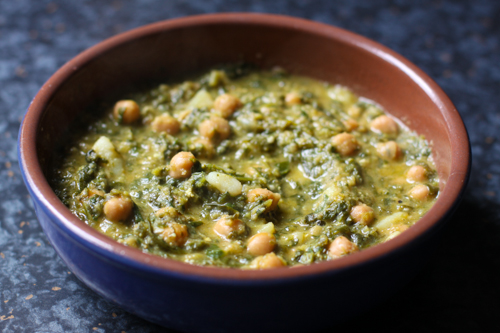Claudia Roden's potaje de garbanzos y espinacas
 Monday, November 5, 2012 at 8:41PM
Monday, November 5, 2012 at 8:41PM (Chickpea and spinach stew)
For my birthday my Mum gave me Claudia Roden’s fabulous cookbook, The Food of Spain. I love this book because the recipes are real and unadulterated Spanish food. The other Spanish cookbooks I have are full of extravagant recipes that are difficult or very expensive to source ingredients for in London or which are too fiddly to make for anything other than a special occasion. Roden’s book is full of the kind of recipes Spanish people actually cook and eat regularly.
I have tried to replicate this Spanish staple several times before and, until now, it never tasted quite like it does in Spain. I have a good palate for detecting spices, and got close with that, but I would never have guessed that the key to it’s “rich texture” and “intriguing flavour” comes from a paste made of stale bread fried with garlic blended to a cream with hard-boiled egg yolks and stock.
The recipe below appears exactly as it does in the book, but just to note that I prefer to dice the potatoes and use floury ones that breakdown through the cooking process, as that more closely replicates the stews I have eaten in bars in Andalucia. I also prefer to use real stock and to cook the chickpeas myself, following Stephanie Alexander’s advice on measurements.
This recipe makes a huge amount of soup. I would recommend halving it, unless you want to eat it days on end. Roden says the full recipe serves six, but even halved I think it would easily serve four for dinner.


Ingredients
3 medium potatoes (500g) peeled and cut into quarters
2 x 400g tins chickpeas, drained
1 litre vegetable or chicken stock, made with 1 stock cube
500g spinach leaves, fresh or frozen and defrosted
1 tablespoon red or white vinegar
Salt
4 tablespoons olive oil
4-5 garlic cloves, peeled
2 slices of bread (about 75g), crusts removed
1 teaspoon pimentón dulce or sweet paprika
1 teaspoon ground cumin
A pinch of ground chilli pepper or cayenne (optional)
2 hard-boiled eggs, peeled, yolks reserved and whites chopped
Method
Put the potatoes and chickpeas into a large pan with about 750ml of the stock, and simmer, covered, for 10 minutes. Put the fresh or frozen spinach leaves on top and cover the pan. Fresh leaves will soften quickly and collapse in the steam. Stir them in. Add vinegar and salt, and cook for 10 minutes more.
Heat the oil in a frying pan and fry the whole garlic cloves and the bread over a medium-high heat, turning them over until golden brown. Keep a careful watch, as they brown very quickly. Drain on paper towels then put in the food processor with the pimentón, cumin and ground chilli pepper, if using, and blend to a fine paste. Add the hard-boiled egg yolks and blend again. Gradually pour in the remaining 250ml stock and blend to a thin cream. Pour this into the soup, stir the chopped hard-boiled egg whites and heat through.
Before serving, add some water if necessary to thin the soup a little – although it is meant to be thick.


 Vix |
Vix |  3 Comments |
3 Comments | 

Reader Comments (3)
This recipe has gotten me very excited for my belated birthday dinner at Movida in a couple of weeks time! I wish you could be there!
YUM
x
Hey Cha, lucky you! Is there one in Sydney now or are you going to Melbourne? MoVida was actually one of the books I was comparing Roden's to - I love it but all the recipes are so intricate/fancy and contain obscure ingredients I can only get at extortionate prices from Borough, if at all, so it is really nice to have a book of basic, traditional Spanish recipes.
Dad cooked us spinach and garbanzos last night ..very good they were.He adds morcilla. I like it with or without